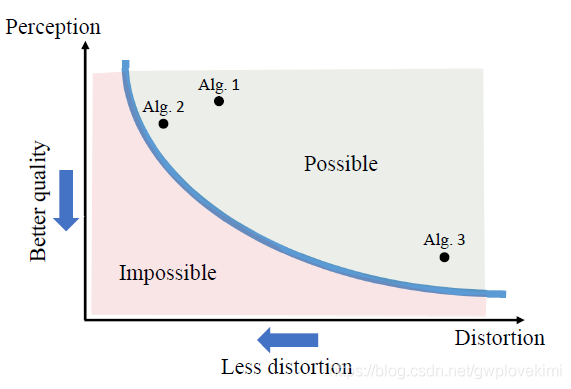閱讀筆記之——《The Perception-Distortion Tradeoff》
本博文為本人閱讀論文《The Perception-Distortion Tradeoff》的學習筆記。這篇論文主要是對超分問題中,感知和失真兩個評價標準進行分析的。
Image restoration algorithms are typically evaluated by some distortion measure (e.g. PSNR, SSIM, IFC, VIF) or by human opinion scores that quantify perceived perceptual quality.(SR問題,對於演算法的評估主要是分為兩類,一類是是畫素維度上的,對於MSE的優化,但這會導致過平滑、模糊等效應。而另外一類,就是基於人眼的直觀感受,比如MOS tset、NIQE,圖片更加的sharp,更加符合人眼的直觀感受,更加的自然,但是會存在的問題,比如原來是直的線,會變成傾斜等~詳細可以參考之前的部落格哈~)而這篇論文就是為了證明mathematically that distortion and perceptual quality are at odds with each other(就是MSE loss和感知損失是對立的)

The goal in image restoration is to estimate an image from its degraded version。Distortion refers to the dissimilarity between the reconstructed image and the original image。Perceptual quality, on the other hand, refers only to the visual quality of reconstructed image, regardless of its similarity to original image.
超分問題中的loss分為以下幾種:
- Distortion (fullreference) measures——指重建影象與原始影象之間的,重建影象的整體與參考影象越像,評價指標越高。以MSE為代表
- Perceptual quality(感知評判因子)——is the degree to which it looks like a natural image, and has nothing to do with its similarity to any reference image.
- Human opinion based quality assessment
- No-reference quality measures——No-reference quality measures are commonly based on estimating deviations from natural image statistics.,such as NIQE
- GAN-based image restoration——an adversarial loss,which minimizes some distance between the distribution of images produced by the generator and the distribution of images in the training dataset.(最小化了由生成器生成的影象的分佈與訓練資料集中的影象分佈之間的一些距離。)
